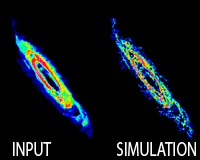ASKAP simulations show idealised images of the sky17 February 2014 Since recently going 'live' at the iVEC Pawsey Centre, the ASKAP Central Processor is now being put through its paces in preparation for processing early science observations from CSIRO's ASKAP telescope. While early stages of commissioning continue at the Murchison Radio-astronomy Observatory (MRO), the ASKAP Computing team has meanwhile been refining processing pipelines by running simulated observations on the ASKAP Central Processor. These simulations produce data files that are able to be processed in exactly the same way on the Central Processor as a real observation would. According to Matt Whiting, ASKAP Computing Specialist, this exercise allows the Computing team to develop and test the processing pipelines that will run on the Central Processor, and ensure that they run in the most efficient manner possible on the new system. "Since the simulations can take any image of the sky as input, we're able to test how ASKAP will respond to different types of observations," says Matt, "It provides important information for planning science observations, as well as essential diagnostics for testing the pipeline software deployed on the Central Processor." Due to the large size of typical ASKAP datasets, specific simulation software has had to be developed to accurately model the telescope and handle the large images and data sets. The advantage of running simulations is that input is completely controlled – any idealised image of the sky can be fed in to see what it looks like when ASKAP observes it. The Computing team have developed a range of simulations to test different types of ASKAP observations. For example, to simulate an observation of M31 – the large, nearby Andromeda Galaxy – data provided the ASKAP Survey Science Teams is used as an input and scaled to appear as if it were seven times further away. The resulting simulated image shows how the galaxy would appear if ASKAP were observing it, and demonstrates that all the important features of the galaxy would be recovered. WALLABY Principal Investigator Baerbel Koribalski explains, "While WALLABY will not observe this Galaxy, it will observe the 21-cm line of neutral hydrogen in many galaxies far away, some of which will look like the simulated image. The simulation shows both the observed HI emission of M31 and the simulated HI emission that ASKAP would be able to see if it were observing this galaxy. ASKAP will resolve out some of the extended HI emission, so it looks slightly different, depending on how long the observations are, and how good the UV-coverage is." Running such simulations will continue to be an integral part of the ASKAP software development, as the project progresses through commissioning of the 6-antenna BETA (Boolardy Engineering Test Array) system in preparation for the full fit-out of the ASKAP telescope. Back to Latest ASKAP News page. |
This loads a font easier to read for people with dyslexia.
This renders the document in high contrast mode.
This renders the document as white on black
This can help those with trouble processing rapid screen movements.

